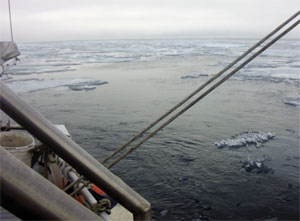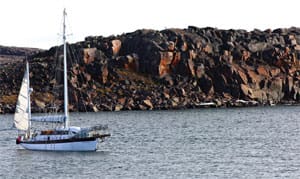To the editor: During our 2014 completion of the Northwest Passage on board my 50-foot gaff-rigged yawl, Empiricus, my fiancé Samantha Merritt and I encountered a large band of high concentration ice. We were able to work our way through that ice with tactics we learned along the way.
We had just cleared James Ross Strait and encountered the first ice since Simpson Strait. A very long, narrow strip of ice blocked our path. It was only 100 to 300 yards thick, but wound east and west for what seemed like forever. We were quite far offshore and she had motored along the ice a good distance looking for an opening.
According to MANICE, the Canadian ice navigation manual, we had encountered a “Jammed Brash Barrier: A strip or narrow belt of new, young or brash ice usually 100 to 5,000 meters across.”
The decision at hand was complex. If we continued motoring around, burning fuel and time, the wind could switch to the west. If that happened before we could clear Bellot Strait, still hundreds of miles north, we would be pinched in the pack and forced to endure the pressure. The other option was to force through the barrier.
“We’re going through,” I said as I guided from the bow. Samantha motored in easy, then we switched places and set to work. I could feel the acid in my throat. Up until now, we moved the boat around the ice. Now, we would move the ice around us.
In reflection of that effort, I’ve written a quick “how to” for would-be ice-mingling types who sail sturdy hulls.
Pressing forward
The engine was always engaged while we pressed through the ice, as was the mainsail for a time — on a broad reach mostly. This provided continual pressure at the bow, so that as the pack moved around us, we moved forward. This helped the ice “roll” off of our hull, so to speak. Also, when there was a movement in the ice ahead, no hesitation was possible. We simply moved as the openings developed. So although our force was minimal (56 hp) in comparison to the obstacle at hand, all energy was constant and well aimed.
This also created the unexpected benefit of prop wash. I shortly discovered that while thrusting forward, any ice to your stern is carried away. This is because the local current from your propeller is contained in the ice flow and becomes a directed narrow band. So, although we were in 10/10 ice, we made a “hole” behind us. A lightbulb went on and a second tactic was developed.
Fanning the stern
As you work through the pack, you will need a constant adjustment of your angle in the ice. I say it that way because when beset, you are not really steering but rather keeping the bow aimed at your next target of ice weakness.
There will be times when you are stuck making no forward progress. During that time, the ice at your stern will move in on each side of your rudder and threaten your steering and propeller. There is a handy trick to deal with this, but it takes some nerve at first.
Begin by slightly turning the helm to one side — for example, a port turn — just a spoke or two as you watch astern and direct the prop wash with the rudder. The stern will begin to walk over to starboard, while also clearing the ice from the port side. While pivoting off the bow, your prop wash will sweep behind you and clear ice aft of the rudder.
Remember to go slow so that your wash is effective. What you want is a pond behind you at all times as your stern fans back and forth in an ever-widening gap. Be careful, as small ice chunks about the size of a garbage can may return to visit your stern, following the back eddy current of your prop wash.
 |
|
Osborn used his rudder to move water and keep the area behind Empiricus ice free. |
|
Jesse Osborn |
After a while, you will have enough room to back up and use other tactics like “ramming” or “redirecting.” It is likely in these conditions that you will face aft more often then forward, which works well while fanning and pivoting against a blockage, but be prepared to turn your head around in a hurry when the bow breaks through. You will be off like a shot and in danger of non-intentional ramming. In our case, I fanned off a particular blockage for more than an hour at 3/4 throttle.
Remember that once you begin to back up, your prop wash will reverse and your pond will close in on you. So make it quick and make it count.
Redirect the bow
If you choose to back, redirecting the bow is usually the best option. But remember that if the flow is moving and reforming, the weak area for which you intend to aim may disappear, so only redirect if you are sure to make progress into your new target. If you are not sure, stay on task and get out some tools. We used a splitting maul and ice poles swung from the bow to break or weaken the heavy ice plates that stopped us. This worked fairly well but was too exhausting as a primary means of progress. Ultimately we resorted to a combination of tool work and ramming to make our way.
Ramming
My boat Empiricus is ridiculously well built. She is 18 inches of Cypress and fiberglass at the bobstay where a one-inch stainless through-hull eye bolt shackles to the 5/8-chain bobstay, which is adjustable with tackle, so it has inherent give. Our gaff rig itself is also low tension. I mention that because I do not advocate ramming a production fiberglass hull with a high-tension bobstay into any ice pack at any time. A tight wire at the waterline would likely snap. In our case, I knew she could take the impact so I proceeded with caution and intermittent observation of the bow between strikes to make sure.
There is no fancy way to say ramming — just back up and hit it. Gently at first, trying to use the minimum amount of force required in order to make way. Movement will come in bursts, so be ready to move and pick your next slot. You may have to stop and fan the stern between each strike, then resume with sharp blows, changing direction quickly. Your engine is going to work here, so keep an eye on your exhaust and make sure raw water is still coming out. Ice can plug your raw water intake and burn the impeller up in minutes.
Once you split the ice, use poles to shove broken pieces down, submerging them then tucking them under the surrounding ice. This will create a path for you. Now idle back to control your speed, but proceed with momentum until you are halted again or free from the pack.
The end result of our effort was success in passing through about 200 yards of 9/10 to 10/10 of mixed ice types. We did this by pressing forward, fanning the stern, redirecting the bow and ramming as appropriate. However, we always looked quite hard for away around the bands after that — even though we knew it was possible. In doing so, we found that sailing quite close to the windward shore usually provided an opening.
All in all, I don’t know if we saved time or not by entering that pack that day. Whether or not we would have found another opening is pure speculation. Regardless of that hindsight dilemma, we found the experience served us well.
—Captain Jesse Osborn spent five years planning and preparing for the Northwest Passage, involving a variety of crewmembers including his two sons, Isaac and Steven. During the voyage 2013-2014 Jesse met his fiancé Samantha in the Arctic where she was working as a bush pilot. Read more at www.empiricusembarks.wordpress.com and www.samanthasails.wordpress.com

